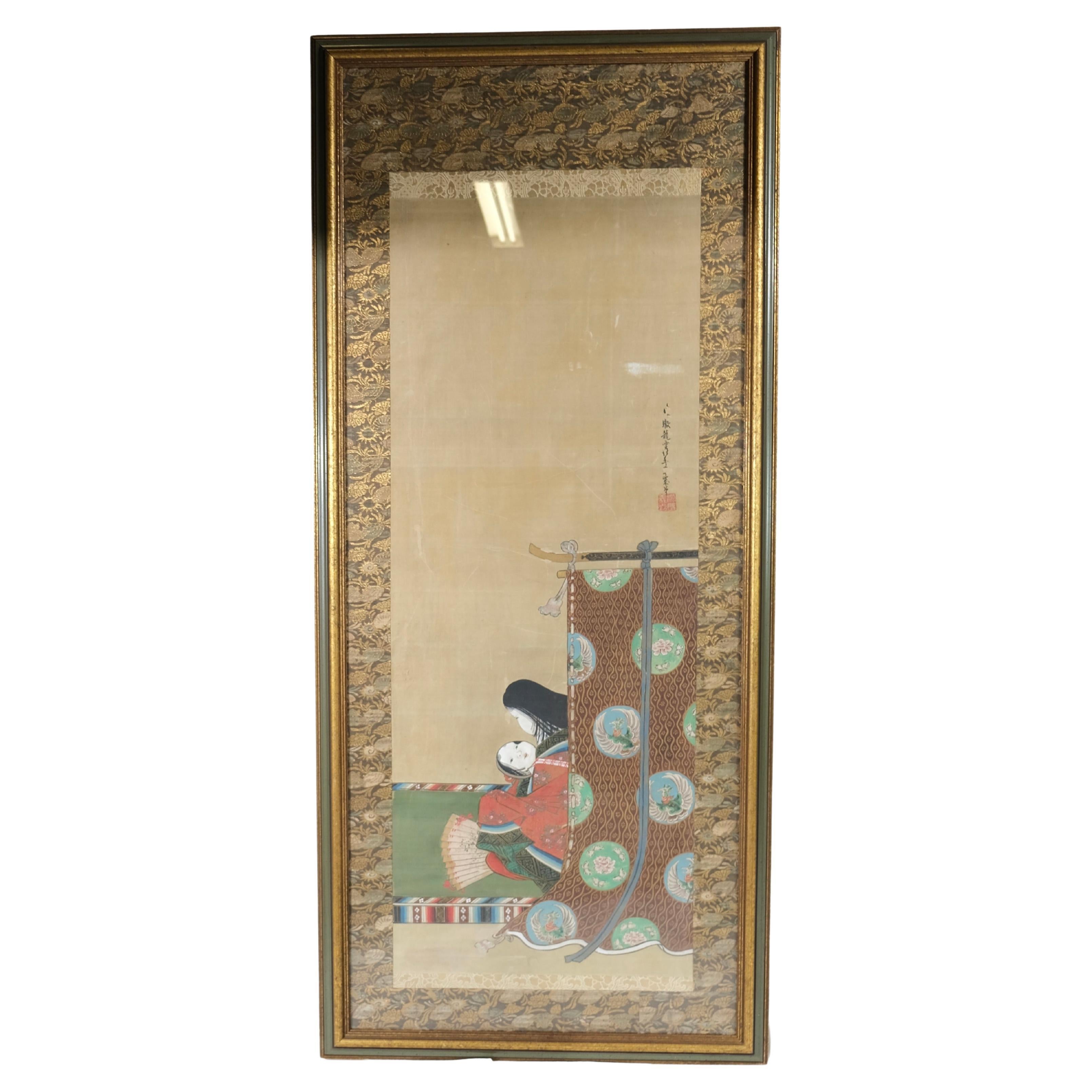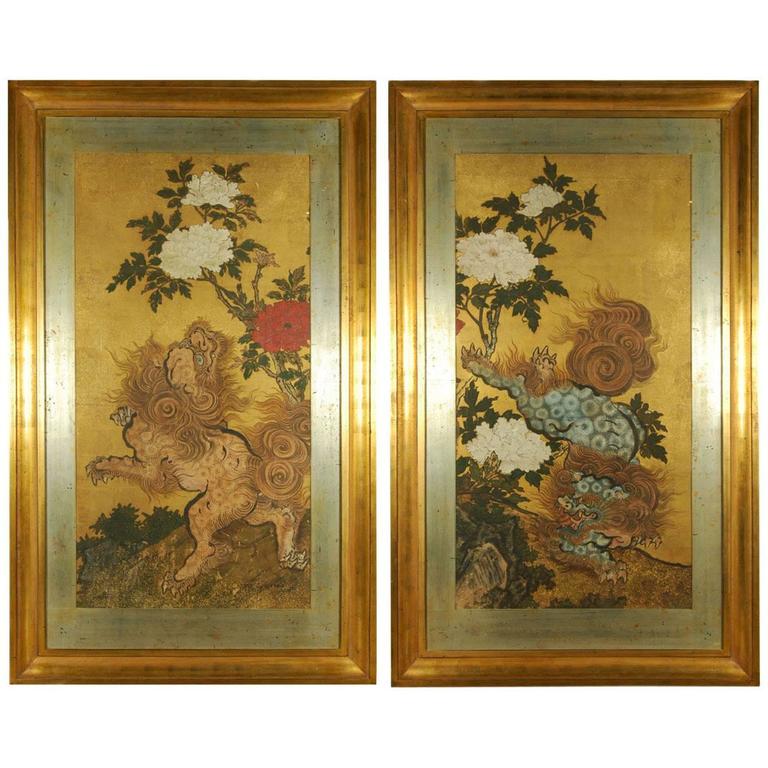Items Similar to Set of 6 Large Kakemonos Japanese Mythology, 19th Century Japan circa 1800 Edo
Want more images or videos?
Request additional images or videos from the seller
1 of 21
Set of 6 Large Kakemonos Japanese Mythology, 19th Century Japan circa 1800 Edo
About the Item
Beautiful set of 6 large kakemonos from 19th century Japanese mythology.
Paper support with a canvas pasted on the paper
Wonderful set that is part of Japan's history and beliefs
When not hung, the Kakemonos are rolled up.
circa 1800 - Japan - Edo Period
A kakemono translates as "object to hang". In Japan this refers to a painting or calligraphy, most often done on silk or paper framed in a scroll that was intended to be hung on walls or in public lighting. This particular form, which allows them to be in a roll, dates back to the Tang dynasty in China (this would be related to the copying and preservation of ancient Buddhist texts). A Kami is a deity or spirit worshipped in the Shinto religion. A Yokai is a spirit, ghost, demon, or strange apparition from the creatures of Japanese folklore.
Each of these kakemonos represents a unique story:
- A kami, a Japanese deity, is shown painting a rainbow. Indeed, he performs the action with his right hand while his left hand holds a kind of basket with three pots of paint. This kami has a rather closed attitude. He is standing in a dark and tormented sky. Below this figure, 8 villagers are dressed in traditional Japanese clothes. Their faces are softened. They are not afraid of the elements made by the kami above their heads.
- A character with an unreal look is holding a kind of jar with his two hands, which he spills on human figures above. This being is floating in the air, probably a character from mythology, perhaps Susanoo. Underneath, villagers on umbrellas. They are trying to protect themselves as best they can from what is falling on them. One of them is carrying baskets with fish on her shoulders. A character in the background is thrown forward and falls.
- On this kakemono, the god Raijin, dressed in a white and blue outfit, strikes the sky with his two drum hammers to create lightning and its thunderous sound. Surrounded by Tomoe and a long red scarf, Raijin, enraged and with dishevelled hair, creates a dark and violent storm. The villagers seem frightened by this meteorological phenomenon. One of the villagers can be seen fainting in the arms of a man. This scene may seem chaotic, but Japanese legend tells us that once a field is struck by lightning, the harvest is good.
- On this kakemono, we see an unreal-looking figure holding a fan, as if he were sweeping away the bad weather, or simply producing gusts of wind. He is probably the kami of wind and air, Shina tsu-hiko. The figures below him seem surprised by so much wind. An umbrella flies away on the left, the women hold their hair and scarf, the clothes are caught in the power of the wind, there is even a woman on the ground on the bottom left.
- This Kakemono represents a short moment. This Raiju is a yokai (ghost spirit, demon from Japanese folklore) that accompanies Raijin, it controls the energy and electricity around and its body is composed of fire or light. Mostly blue in colour, he comes here to create energy and dissipate numerous lightning bolts, taking the villagers by surprise. Some of them even stumble. Traces of old restorations and humidity also
- The kami Kura-Okami seems to be represented, born from the blood of Kagu-Tsuchi (the god of fire according to Japanese mythology, son of Izanami and Izanagi). When Kagu-Tsuchi was born, he burned Izanami to death and Izanagi cut him into 8 pieces which gave birth to 8 deities, and from his blood which flowed on his father's sword 8 other deities were born, including Kura-Okami. Later, Kura-Okami split into two to give birth to Taka-Okami. Both live in the mountains and valleys producing rain and snow. On the kakemono, the kami is making snow fall from the clouds. The characters below are carrying umbrellas for protection. A character is chasing an animal, probably a sheep.
Behind four of them, the same Japanese sign is inscribed at the top, and a different sign on the other two.
- Dimensions:Height: 63.78 in (162 cm)Width: 20.48 in (52 cm)Depth: 0.04 in (1 mm)
- Sold As:Set of 6
- Style:Edo (Of the Period)
- Materials and Techniques:
- Place of Origin:
- Period:
- Date of Manufacture:1800
- Condition:Repaired: Traces of old restorations and humidity also on the one representing the kami of lightning and thunder.
- Seller Location:Beuzevillette, FR
- Reference Number:1stDibs: LU2663326635002
About the Seller
4.9
Platinum Seller
These expertly vetted sellers are 1stDibs' most experienced sellers and are rated highest by our customers.
Established in 2010
1stDibs seller since 2017
243 sales on 1stDibs
Typical response time: 2 hours
- ShippingRetrieving quote...Ships From: Nointot, France
- Return PolicyA return for this item may be initiated within 2 days of delivery.
More From This SellerView All
- A.Bouverat Chinese Inspired Lacquered Panel Hand-Painted 20th CenturyBy A. BouveratLocated in Beuzevillette, FRVery beautiful rare and large lacquer of Chinese inspiration. Representation of a green space with many plants such as cherry trees and magnolia. A bird crosses the lacquer with its ...Category
20th Century French Chinoiserie Paintings
MaterialsLacquer
- Watercolor Venizia Bridge of Sighs circa 19th CenturyLocated in Beuzevillette, FRNice little watercolour representing the city of Venice in Italy. We see a gondolier on the Rio de la Canonica canal located between the Ducal Palace and the prison. These two buildings are linked by the famous Bridge of Sighs...Category
Antique 19th Century Italian Paintings
MaterialsPaper
- Immortal He Xiangu Painting on Canvas, China, 19th Century Asian ArtLocated in Beuzevillette, FRChinese painting depicting He Xiangu reproduced three times but with a different attribute: up a lotus flower, bottom left a fly hunt and bottom right again the lotus flower, each time surrounded by disciple the one praying right, the one on the left seems to bring him a bowl. Pigments on linen or hemp, 19th century. He Xiangu or Ho Hsien-ku, "Immortal Demoiselle He," is an immortal Taoist, a member of the group of Eight Immortals. She is represented holding in her hand a lotus symbolizing spiritual fulfillment, and sometimes also a sheng, a peach of immortality, a wooden ladle...Category
Antique 19th Century Chinese Qing Paintings and Screens
MaterialsCanvas
- Painting Oil on canvas Picture of a Navy - 19th Century - FranceLocated in Beuzevillette, FRBeautiful oil on canvas from the 19th century representing a navy. In the foreground, a three-masted ship is moored in the basin, further on we can see other ships and also a quay. V...Category
Antique 19th Century French Paintings
MaterialsCanvas
- Combe-Velluet Watercolor Landscape France 19th CenturyLocated in Beuzevillette, FRLandscape of a plain in watercolor on paper. This painting of warm colors reveals a tree-like vegetation that seems to move to the rhythm of the wind. Created by the French paint...Category
Antique Late 19th Century French Paintings
MaterialsPaint, Paper
- "The Three Ages of Man" Oil on Canvas After Titian 19th CenturyLocated in Beuzevillette, FRThis very beautiful oil on canvas is a reworking of the left part of the painting The Three Ages of Man" by the Italian Renaissance master of the Venetian school, Tiziano Vecellio, k...Category
Antique 19th Century Renaissance Paintings
MaterialsPaint
You May Also Like
- Japanese Kakemono, 19th CLocated in Stockholm, SEA Japanese kakemono depicting o woman watching herself in a mirror and the mirror reflecting her image. A good quality kakemono.Category
Antique 19th Century Japanese Paintings and Screens
MaterialsSilk, Paper
- 19th Century Japanese Edo Six Panel Kano School Landscape ScreenLocated in Rio Vista, CALate Edo period 19th century Japanese six-panel landscape screen featuring a cypress tree over a flowering hibiscus with a pair of hototogisu birds. Kano school painted with ink and ...Category
Antique 19th Century Japanese Edo Paintings and Screens
MaterialsSilk, Wood, Paper
- Japanese Six Panel Screen with Hotei, Edo Period, Early 19th CenturyLocated in Austin, TXA delightful Japanese six panel painted paper screen featuring the beloved figure Hotei, Edo Period, early 19th century. Hotei, called Budai in China, and known as the Laughing Buddha or Fat Buddha in the West, is considered to be an emanation of Maitreya, the Buddha of the Future. In Japan, he also holds a special place as one of the Seven Lucky Gods, being the god of fortune, and protector of children. He is always portrayed as a mirthful and corpulent man, dressed in loose robes that show off his round belly. He carries a sack with him, said to be filled with treasure. As the protector of children, he is often portrayed with them playing on or around him, as he is here. The children portrayed in this screen are dressed in Chinese style clothing...Category
Antique Early 19th Century Japanese Edo Paintings and Screens
MaterialsSilk, Paper
- Edo Period 19th Century Japanese Folding Screen Six Panels Flowers on Gold LeafBy Rimpa SchoolLocated in Brescia, ITClouds of gold, water and many colorful flowers: Japanese six-panel folding screen by Rimpa School. Hand painted with rice mineral pigments and inks on rice paper and gold leaf.Category
Antique Early 19th Century Japanese Edo Paintings and Screens
MaterialsGold Leaf
- Pair of Antique Japanese Paintings of Karashishi, Edo Period, 18th CenturyLocated in Prahran, VictoriaA rare pair of antique Japanese Karashishi paintings in a landscape of rocks and peony flowers on gold leaf ground in fine handmade frames, Edo period, early 18th century. The Karash...Category
Antique Early 18th Century Japanese Edo Paintings and Screens
MaterialsGold Leaf
- 19th Century Japanese Scroll Painting, Birds & Flowers of the Four SeasonsLocated in Kyoto, JPBirds and flowers of the four seasons Early to mid-19th century Ink, pigment and gofun on silk Unidentified artist Signature: S...Category
Antique 1830s Japanese Edo Paintings and Screens
MaterialsSilk





